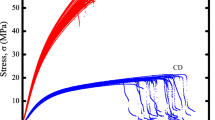Abstract
An attempt has been made to apply the concepts of fracture mechanics to describe the behaviour of a paper sheet with a crack. Considering paper as an orthotropic homogeneous continuum, the critical strain energy release rate, G c, for eight different papers has been measured using linear elastic fracture mechanics. Also, a direct measurement of work of fracture, R, has been made for these samples by using the quasi-static crack propagation technique. For both techniques, results independent of specimen dimensions were obtained. G c and R were found to be experimentally equivalent. The fracture toughness of paper has been compared with that of other engineering materials.
Similar content being viewed by others
Abbreviations
- a :
-
Initial crack length (cm)
- a ij :
-
Elements of compliance matrix ā (cm2 dyn−1)
- A :
-
Area of fractured surface (cm2)
- b :
-
Specimen width (cm)
- E :
-
Young's modulus (dyn cm−2)
- E 1 :
-
Young's modulus in the machine direction (dyn cm−2)
- E 2 :
-
Young's modulus in the cross direction (dyn cm−2)
- E θ :
-
Young's modulus at angle θ to the machine direction (dyn cm−2)
- F :
-
Finite-width correction factor
- G :
-
Strain energy release rate (erg cm−2)
- G c :
-
Critical strain energy release rate (erg cm−2)
- K :
-
Stress intensity factor (dyn cm−3/2)
- K c :
-
Critical stress intensity factor (dyn cm−3/2)
- l :
-
Specimen length (cm)
- r y :
-
Size of plastic zone (cm)
- R :
-
Work of fracture (erg cm−2)
- t :
-
Specimen thickness (cm)
- U :
-
Strain energy (erg)
- θ :
-
Angle in the plane of the sheet measured from the machine direction
- ρ :
-
Specimen density (g cm−3)
- σ c :
-
Gross tensile stress at fracture (dyn cm−2)
- σ N :
-
Net tensile stress at fracture (dyn cm−2)
- σ ys :
-
Tensile yield stress (dyn cm−2)
References
A. R. Jones, Tappi 51 (1968) 203.
L. Nordman, “Fundamentals of Papermaking Fibres”, (edited by F. Bolam) (Tech. Sect. British Paper and Board Makers' Assoc., Kenley, 1958) p. 333.
D. H. Page and P. A. Tydeman, “The Formation and Structure of Paper”, (edited by F. Bolam) (Tech. Sect. British Paper and Board Makers' Assoc., London, 1962) p. 397.
G. R. Sears, R. F. Tyler and C. W. Denzer, Pulp Paper Mag. Can. 66 (1965) T351.
F. A. Macmillan, W. R. Farrell and K. G. Booth, Pulp Paper Mag. Can. 66 (1965) T361.
V. Balodis, Aust. J. Appl. Sci. 14 (1963) 284.
O. Andersson and O. Falk, Svensk Papperstid. 69 (1966) 91.
C. Gurney and J. Hunt, Proc. Roy. Soc. A 299 (1967) 508.
P. C. Paris and G. C. Sih, “Fracture Toughness Testing and its Applications”, STP 381 (ASTM, Philadelphia, 1965) p. 30.
G. R. Irwin, “Proceedings of the 7th Sagamore Ordnance Materials Research Conference” (Syracuse University Research Institute, August, 1960) p. IV-63, Met. E. 661-611/F.
G. R. Irwin, “Handbuch der Physik”, (edited by S. Flügge) Vol. 6 (Springer-Verlag, Berlin, 1958) p. 551.
G. C. Sih, P. C. Paris and G. R. Irwin, Int. J. Fracture Mech. 1 (1965) 189.
J. Glucklich, Engng. Fracture Mech. 3 (1971) 333.
Progress in Measuring Fracture Toughness and Using Fracture Mechanics: Fifth Report of a Special ASTM Committee, Materials Research and Standards 4 (1964) 107.
F. A. McClintock and G. R. Irwin, “Fracture Toughness Testing and its Applications”, STP 381 (ASTM, Philadelphia, 1965) p. 84.
J. E. Srawley and W. F. Brown, Jun., “Fracture Toughness Testing and its Applications”, STP 381 (ASTM, Philadelphia, 1965) p. 133.
C. L. Mantell (Ed.), “Engineering Materials Handbook”, (McGraw-Hill, New York, 1958) p. 1–40.
O. L. Bowie, J. Appl. Mech. 31 (1964) 208.
S. G. Lekhnitskii, “Theory of Elasticity of an Anisotropic Elastic Body” (Holden-Day, San Francisco, 1963) p. 41.
G. T. Hahn, M. F. Kanninen and A. R. Rosenfield, “Annual Review of Materials Science”, (edited by R. A. Huggins) Vol. 2 (Annual Reviews Inc., Palo Alto, 1972) p. 381.
H. G. Tattersall and G. Tappin, J. Mater. Sci. 1 (1966) 296.
R. J. Ferguson, G. P. Marshall and J. G. Williams, Polymer 14 (1973) 451.
H. J. Konish, Jun, J. L. Swedlow and T. A. Cruse, J. Composite Materials 6 (1972) 114.
C. D. Ellis and B. Harris, ibid 7 (1973) 76.
R. J. Sanford and F. R. Stonesifer, ibid 5 (1971) 241.
Author information
Authors and Affiliations
Rights and permissions
About this article
Cite this article
Seth, R.S., Page, D.H. Fracture resistance of paper. J Mater Sci 9, 1745–1753 (1974). https://doi.org/10.1007/BF00541741
Received:
Accepted:
Issue Date:
DOI: https://doi.org/10.1007/BF00541741




